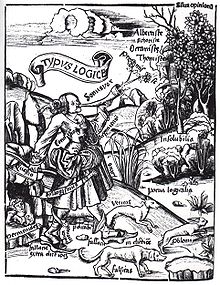Gregor Reisch
Gregor Reisch (* approx. 1470 in Balingen ( Württemberg ); † May 9, 1525 in Freiburg im Breisgau ) was a philosopher and Carthusian . He is a representative of the philosophical school of the late scholastic realists.
biography

Gregor Reisch was born between 1467 and 1470 in Balingen , Württemberg ; his date of birth is unknown. On 25 October 1487 he was at the University of Freiburg Breisgau enroll . During his studies he was an alumnus of the student burse Domus Cartusiana . In 1488 he acquired the degree of a Baccalaureus and in 1489 the title of Magister Artium . After working as a university lecturer, Gregor Reisch joined the Carthusian order around 1496 . In 1501 he was prior of the Buxheim monastery and a year later, in 1502, prior of the Freiburg monastery on Johannisberg , which he remained until his death. From 1508 he also worked as a visitor to the Rhenish order province and in 1521 as deputy to the superior of the order in the Grande Chartreuse . He died on May 9, 1525 in Freiburg im Breisgau.
In addition to the Freiburg humanists , Reisch's scientific circle also included Beatus Rhenanus , Jakob Wimpheling , Johann Geiler von Kaysersberg , Konrad Pellikan , Johannes Reuchlin and, at times, Erasmus von Rotterdam . His most famous students were Johannes Eck , Martin Waldseemüller and Sebastian Münster . Gregor Reisch was an opponent of the teachings of Luther and the emerging Protestantism . From 1509 Reisch became a close confidante of Emperor Maximilian I.
Fonts
- 1503: Margarita philosophica totius Philosophiae Rationalis, Naturalis & Moralis principia dialogice duodecim libris complectens. Freiburg 1503. Further editions in 1504 (with the first illustration of Freiburg) as well as 1508, 1517 and 1519; to be distinguished from the unauthorized and z. Partly changed editions by Hans Grüninger in Strasbourg from 1504, 1508, 1512 and 1515; Reprint of the edition from 1508 ( Margarita philosophica cum additionibus novis. M. Furter & J. Schott, Basel 1508): Whitefish, Montana without year.
Explanation of the figure
The illustration is entitled TYPUS ARITHMETICAE and appears in Margarita philosophica in front of the 4th book De quadrivii rudimentis , which deals with arithmetic. The personified Arithmetica holds an open book in each hand, probably with a description of the two computing systems shown in the picture; on her dress are the beginnings of two rows of geometrical numbers: 1 - 2 - 4 - 8 and 1 - 3 - 9 - 27. In the foreground are two tables, on the right a calculator and behind it Pythagoras , on the left a table with numbers and symbols and behind it Boethius . In the Middle Ages, Pythagoras was (erroneously) considered to be the inventor of the abacus arithmetic which has been widespread since ancient times, the "arithmetic on the line"; the calculation bank has four horizontal lines on which "arithmetic pennies" are used; each line means a digit in the system of ten; the lines for the thousands and millions bear lying crosses; the bottom line is the ones-line; if a penny lies between two lines, that means five units of the bottom line. On the left side of the picture Boethius, mistakenly called the inventor of the Arabic numerals in the Middle Ages, shows the advantages of the calculation method with Arabic numerals, the "calculation on the pen"; As is well known, 0 is added to the digits 1 to 9, which in itself is “nothing” but can increase the previous digits tenfold.
literature
- Ulrich Becker: The first encyclopedia from Freiburg around 1495. The pictures of the “Margarita Philosophica” by Gregorius Reisch. Prior of the Charterhouse . Freiburg 1970, p. 40 ff.
- Lutz Geldsetzer (ed.): Margarita philosophica. With a foreword, an introduction and a new table of contents by Lutz Geldsetzer . Düsseldorf 1973
- Otto and Eva Schönberger : Gregor Reisch, Margarita philosophica - pearl (treasure) of philosophy . Translation of the 4th edition Basel 1517. Königshausen & Neumann, Würzburg 2016, ISBN 978-3-8260-5943-8
- Frank Büttner: The illustrations of the Margarita Philosophica of Gregor Reisch. In: Frank Büttner, Markus Friedrich, Helmut Zedelmaier (eds.): Collecting - arranging - illustrating. On knowledge compilation in the early modern period . Münster 2003, pp. 269-300.
- Steffen Siegel: Architecture of Knowledge. The figurative order of artes in Gregor Reisch's Margarita Philosophica . In: Frank Büttner, Gabriele Wimböck (ed.): The image as an authority. The normative power of the image. LIT Verlag, Münster 2004, ISBN 3-8258-8425-2 , pp. 343-362.
- Hans Georg Wehrens: Gregor Reisch, his Margarita philosophica and Freiburg im Breisgau. In: Journal of the Breisgau history association "Schau-ins-Land". Freiburg 2004, pp. 37-57.
- Heinrich Ritter von Srbik : The margarita philosophica of Gregor Reisch († 1525). A contribution to the history of natural science in Germany. In: Memorandum of the Academy of Sciences in Vienna, mathematical and natural science class. Volume 104, 1941, pp. 83-205.
- Gilbert Hess: Reisch, Gregor (ius). In: New German Biography (NDB). Volume 21, Duncker & Humblot, Berlin 2003, ISBN 3-428-11202-4 , pp. 384-386 ( digitized version ).
- Carl von Prantl : Reisch, Gregor . In: Allgemeine Deutsche Biographie (ADB). Volume 28, Duncker & Humblot, Leipzig 1889, p. 117.
Web links
- Literature by and about Gregor Reisch in the catalog of the German National Library
| personal data | |
|---|---|
| SURNAME | Reisch, Gregor |
| ALTERNATIVE NAMES | Rusch de Balingen |
| BRIEF DESCRIPTION | Carthusian prior and opponent of the Reformation |
| DATE OF BIRTH | around 1470 |
| PLACE OF BIRTH | Balingen , Württemberg |
| DATE OF DEATH | May 9, 1525 |
| Place of death | Freiburg in Breisgau |


